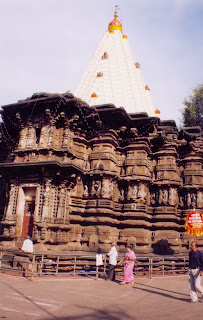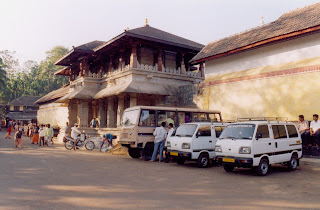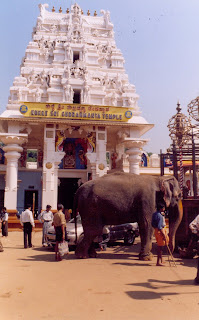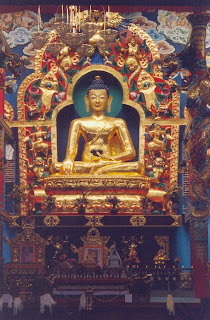 Ishwara Shrine atop Mulainagiri, the highest peak in Karnataka
Ishwara Shrine atop Mulainagiri, the highest peak in KarnatakaHowever, the Rig Veda, the most ancient text available, does not feature this mountain range as possibly during that time the peninsular part of India was a dense forest and remained largely inaccessible and unknown to the Vedic people.
 Madhukeshwara Temple, Banvasi, Karnataka
Madhukeshwara Temple, Banvasi, KarnatakaKishkindha Kanda and Yuddha Kanda in Ramayana and Ashvamedha Parva and Udyog Parva in Mahabharata have references to the majestic and lofty mountain ranges on the west coast. There are two names that feature for the Western Ghats - Sahya and Malaya. The name Sahya was probably applied to the northern segment of the mountain range in Maharashtra and Karnataka, and Malaya to the southern segment in Kerala and Tamil Nadu.
The Legend of Parashurama
The legend of Parashurama is a popular story in the Hindu Mythology with different regional versions. According to one version, Parashurama, the axe-wielding avatar of Vishnu is the son of Sage Jamadagni and Renuka. Jamadagni is killed by despotic Kshatriyas because he refuses to part with ���Kamadhenu���, his wish-fullfilling divine cow. In revenge, Parashurama traverses the earth twenty-one times and wipes out all the Kshatriyas.
Parashurama, struck by remorse tried to expiate his sins by performing yagnyas during which he gifted away all his lands to the Brahmins with no land left even to build a hermitage for himself. Varuna, God of the seas came to his aid and offered him to gain from the sea as much land he could span in one throw of his axe. Parashurama stood at Pethe Parashuram (near Chiplun, Maharashtra) and threw his axe as far as Kanyakumari. The sea retreated and the coastal tracts of Konkan, Kanara and Kerala were thus generated.
Parashurama populated his new lands with Brahmins as well as new plants such as the coconut, the banana and the jackfruit which now thrive throughout the region.
This legend is probably based on the lowering of sea level which resulted in the emergence of the coastal strip which is now referred to as Konkan and Malabar. There are very few shrines to Lord Parashurama - apart from Pethe Parashuram in Konkan, there is one shrine in Goa at Painguinim and two in Kerala at Payanur and Thiruvallom.
From the earliest times, the mountains have been considered the abode of Gods and revered and worshipped. There are hundreds of shrines and temples built atop the hills and innumerable caves and monuments dedicated to the divine all over the Western Ghats. Skanda Purana has a whole section called Sahyadri Kanda that provides description of over a hundred Tirthas (holy places in the vicinity of rivers) and eighty Kshetras (places of pilgrimage) in the Sahyadri range.
 Vidyashankara Temple, Shringeri, Karnataka
Vidyashankara Temple, Shringeri, KarnatakaThe Tirtha phenomenon is a unique by-product of Indian culture. Rivers, mountains, shrines and holy spots on the banks of rivers have been sanctified by tradition and association and visit to these places has been considered for centuries as a paramount duty of a Hindu.
Some of the important tirthas are located at the source of different rivers. Tryambakeshwar is located at the source of Godavari near Nasik and contains one of the twelve ancient and sacred Jyotirlingas in India.
The legend of sage Gautama who resided near Tryambak on the Brahmagiri hill is narrated in Brahmapurana and Naradapurana. Ramayana features Panchavati on the banks of Godavari near Nasik where Shri Rama stayed along with Sita and Lakshaman.
 Bhimashankar Temple, Maharashtra
Bhimashankar Temple, MaharashtraRiver Bhima rises 40 km north of Khandala and at the source of this river is situated another of the twelve famous Jyotirlingas of Bhimashankar. Bhima is referred to in the Mahabharata, Matsya Purana, Brahma Purana and Vamana Purana. Most of the famous Ashta Vinayaka temples of Maharashtra are located in the Sahyadris - Lenyadri, Siddhatek, Pali, Theur, Morgaon, etc.
River Krishna rises near Mahabaleshwar along with four other rivers - Vena, Kakudmati, Savitri and Gayatri. The Shiva (Mahabaleshwara) temple is about 5 kms from the main bazar of Mahabaleshwar hill station. There are legends associated with this spot in Mahabaleshwar Mahatmya.
Pandharpur situated 40 miles west of Sholapur on the banks of river Bhima also known as Chandra-bhaga is the foremost pilgrimage centre of Maharashtra that houses the famous shrine of Vithoba.
Alandi is situated on the banks of Indrayani river 12 miles north of Pune and has the Samadhi and shrine of the famous Maharashtra saint Jnaneshwar. On the mountain at Jejuri, high up the Karha valley is the temple of Khandoba.
Kolhapur is situated near the banks of river Panchaganga and is known for the ancient temple of Goddess Mahalakshmi.
 Mahalakshmi Temple, Kolhapur
Mahalakshmi Temple, Kolhapur Saptakoteshwar Temple, Narve, Goa
Saptakoteshwar Temple, Narve, GoaBaba Budan or Dattatreya Pitha, a laterite cave, considered holy by both Muslims and Hindus is in the Bababudan range. The legend says that the Muslim saint Baba Budan came and settled down here and brought coffee seeds with him from Persia. This was the beginning of coffee crop in India. Close to Chickamagalur, on the tallest peak in the Western Ghats of Karnataka - Mulaianagiri (1,923 m.) is a beautiful Shiva shrine.
 Nageshwar Temple, Saputara, Gujarat
Nageshwar Temple, Saputara, GujaratAt the foothill of the Western Ghats at Belur and Halebid near Hassan are the Temples of Channakeshava and Hoysaleshwara with finely executed carved sculptures. These were built during the 12th century and are the finest examples of Hoysala architecture.
North of Udupi, near the base of the Kodachadri hills is the famous temple of Goddess Mookambika at Kollur. Udupi in Dakshina Kannada is famous for Krishna temple founded by Sri Madhavacharya, the great Dvaita philosopher and teacher. Kukke Subramanya temple at the base of the Kumara Parvata is in Dakshina Kannada.
 Mukambika Temple, Kollur, Karnatak
Mukambika Temple, Kollur, Karnatak Kukke Subramanya Temple, Karnataka
Kukke Subramanya Temple, KarnatakaSabrimala the famous abode of Lord Ayyappa is situated in thick forested area of the Western Ghats in the upper region of river Pamba in Kerala. The legend says that it was here that lord Rama while searching for Sita met Sabari, an ardent devotee and blessed her. The famous ancient temple of Lord Krishna is situated in Guruvayur, about 30 km from Trichur.
Kaladi, eight miles east of Alwaye, on the banks of river Periyar is the birth place of Jagatguru Sri Shankaracharya.
River Tambraparni arises in the Agasthyamalai hills. After a few kms from its source downstream, it reaches the Papanasam tirtha which is considered a very sacred place. The importance of the tirtha is described in the Shiva Purana and in the Kurma Purana and it is also mentioned in the Mahabharata and Ramayana. There is a temple of Subramanya at Palni hills on a rocky hill about 450 ft high.
 Carved figurine, Belur Temple
Carved figurine, Belur TempleThe 34 caves at Ellora and 29 caves at Ajanta remained shrouded in obscurity till one John Smith, a British Army officer, accidentally stumbled upon them while hunting tigers in 1819. These caves were built as secluded retreats for the Buddhist monks around 2nd century B.C.
 Ajanta Fresco
Ajanta FrescoThe Kailasa temple in Cave 16 at Ellora is an architectural marvel, the entire structure having been carved out of a monolith, the process having taken over a century to finish. The gateway, pavilion, assembly hall sanctum and tower, all hewn out of a single rock. What is amazing about it, is the fact that unlike other temple structures which are built base upward, the architect involved here, started carving from the very top and the sides. Gigantic though, it remains one of the most delicate and intricate ancient works of art.
Junnar, where the hill fort of Shivneri is situated was an old Buddhist centre and it still has several cells and chapels and believed to be as old as 3rd century B.C.
The other important Buddhist caves are at the Bhore or Khandala pass at Karla, Bhaje and Bedse. The Buddhist cave at Karla is considered to be the largest and the most complete Chaitya cave in India and is also the best preserved. The caves of Bhaje and Bedse are also nearby and are believed to be as old as 2nd century B.C.
The Gandhar-Pali caves are located near Mahad junction on Mumbai-Goa highway in the Sahyadris. There are 28 caves in all which date back to the 2nd or 3rd century A.D. Chaityas, Viharas, wall sculptures, images of Buddha can be seen in these caves.
 ���Golden Buddha���, Namdroling Monastery, Bylakuppe, Kodagu
���Golden Buddha���, Namdroling Monastery, Bylakuppe, KodaguJain Pilgrimage Centres
Ellora : Of the 34 caves that are carved, 5 of the caves to the north are Jain caves.
Shravanabelagola : This famous Jain pilgrimage centre is located 51 km south east of Hassan. The Gomateshwara statue 58 ft high is carved out of a mountain and said to be one of the tallest monolithic sculptures. It was carved out in 981 A.D. and consecrated in 983 A.D. There are several Jain bastis and monasteries in Shravanabelagola. There are 14 shrines on Chandragiri hill and Chandragupta Maurya, the Mauryan Emperor after renouncing his kingdom settled on this hill, along with his Guru Bhagwan Bhadra Bahu Swami. The great emperor is buried here.
 Gomateshwara, Shravanbelagola
Gomateshwara, ShravanbelagolaMoodabidri : The Savira Khamba Basadi is the most well-known of the 18 Jain Temples here. There is also the 17th century Chowta Palace, the intricately carved residence of the Jain Royal family.
Kumbhojgiri : This centre is 35 km away from Kolhapur. There are around 24 temples dedicated to Jain Tirthankars within the complex, sacred to both Digambara and Swetambara sects.
Christian Pilgrimage Centres
St. Thomas, the apostle is believed to have travelled by the spice route on a boat and landed in Muziris (Cranganore) in 52 A.D. He converted India���s first Chiristians and built a church at Palayur. The Palayur is the oldest of the seven-and-half churches founded by St. Thomas, and is the oldest church in India.
Malayattoor, on the banks of the Periyar is a popular pilgrim centre for the Christians of Kerala as they believe that it was blessed by the presence of St. Thomas the apostle. About 10 kms from Vagamon is Kurusimala, a pilgrim centre for Christians, that recreates Christ���s final journey - the Way of the Cross - in a series of picture tableaux.
 'Bom Jesus', Old Goa
'Bom Jesus', Old GoaOld Goa is famous for the Shrine of St. Franacis Xavier "Bom Jesus" where his entombed body has been kept.
Aurangazeb���s Tomb
North-East of Mumbai in the Western Ghats is a small hill station of Khuldabad, site of the tombs of Aurangzeb, last of the great Mogul Emperors and his son Azam Sham.
Aurangzeb chose Rauza on Khuldabad���s outskirts as his resting place where he wanted to be buried. Aurangzeb chose this simple town for the most feared of the Mogul emperors saved money for this simple structure through the sale of skullcaps that he stitched and copies of the Koran he personally wrote.

3 comments:
I really like what you write, provide useful knowledge
what are the types of ghats in india .
I just read your blog and it really interesting blog on Western ghat.Running along the entire west coast of India, the mountains of the Western Ghats are no snow-peaked Himalayas.Thanks for share.We have an International flight services for Shirdi Temple in India. shirdi airport |. shirdi airport flights
Excellent post i just read your blog & really intresting.
https://prayaanhospitality.com/kumbhalgarh
Post a Comment